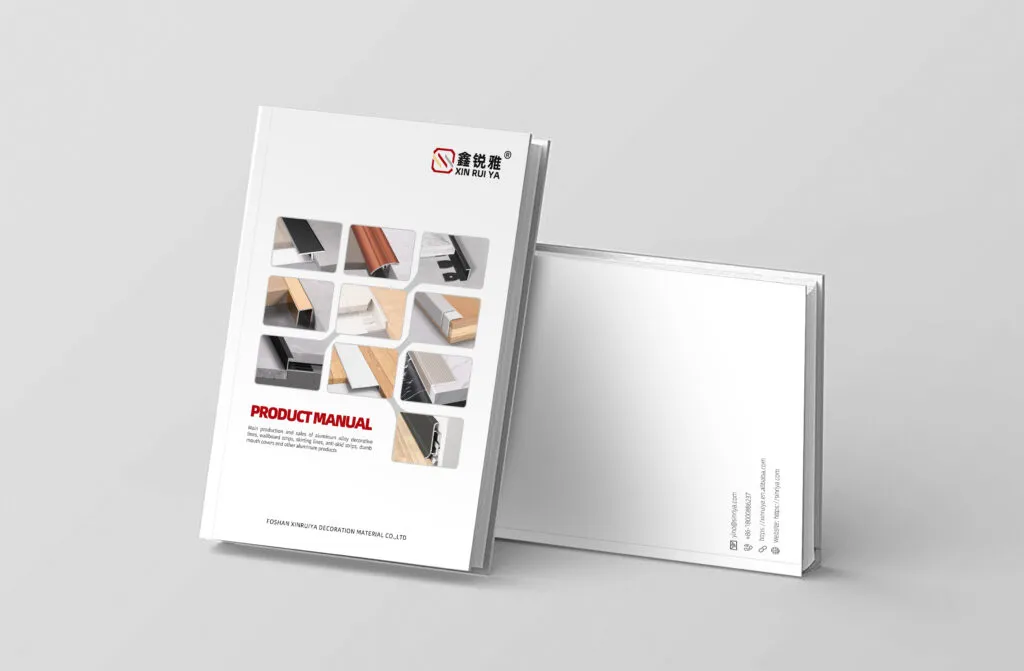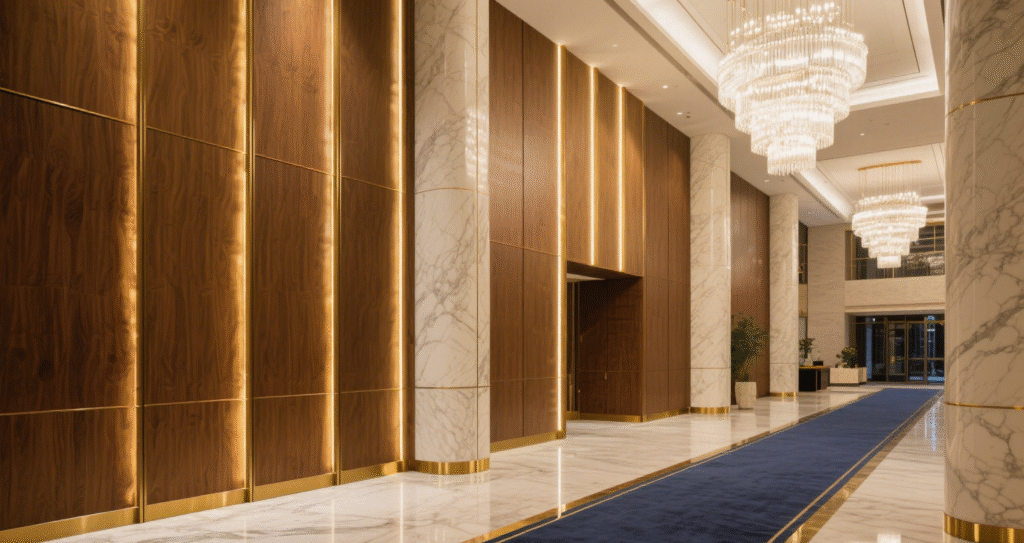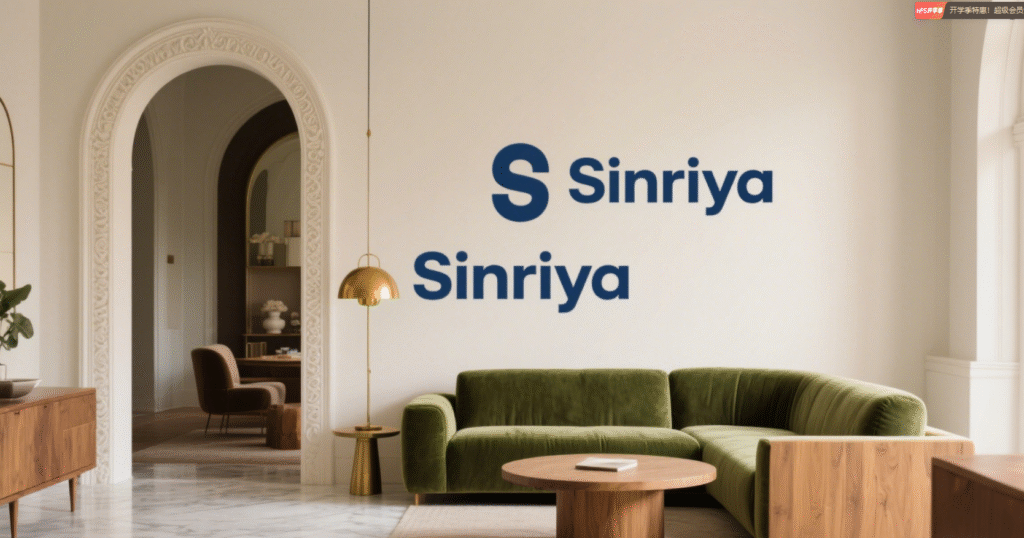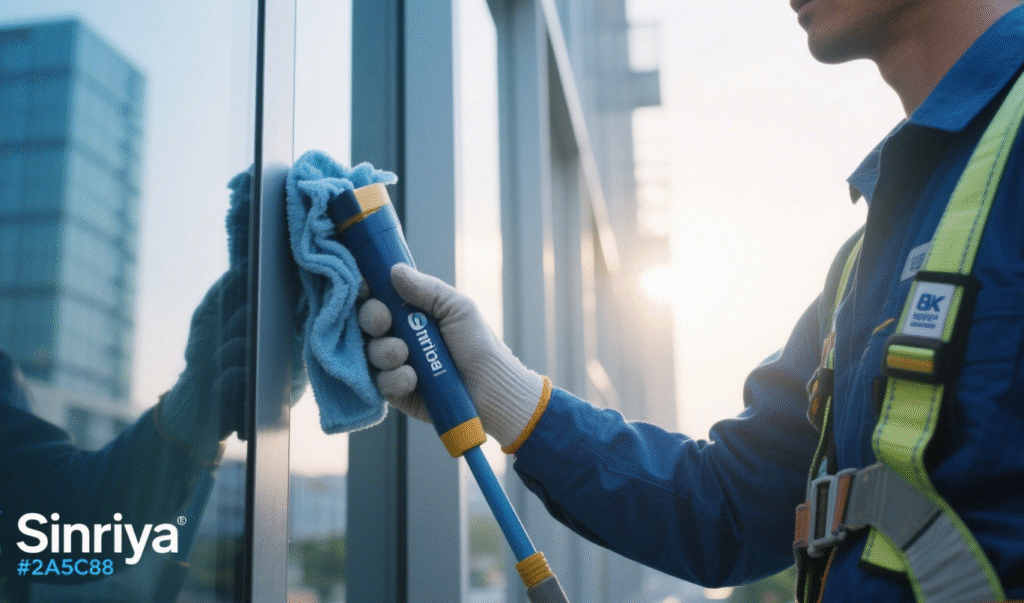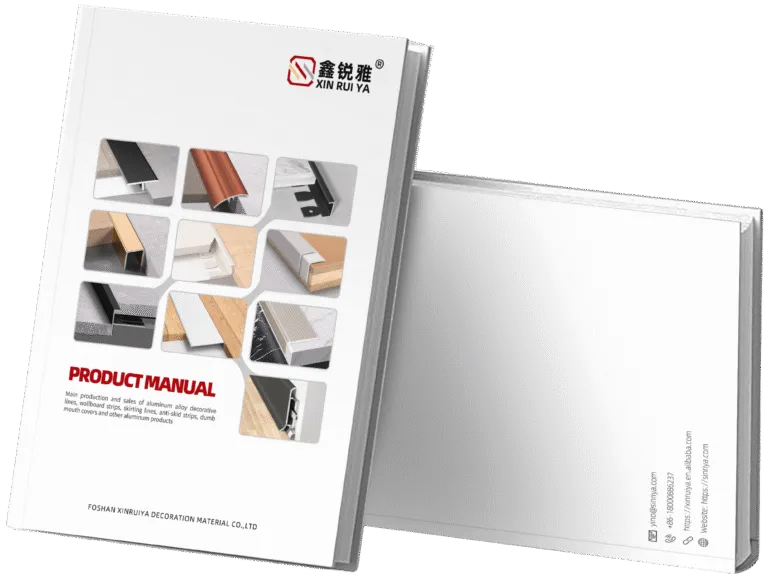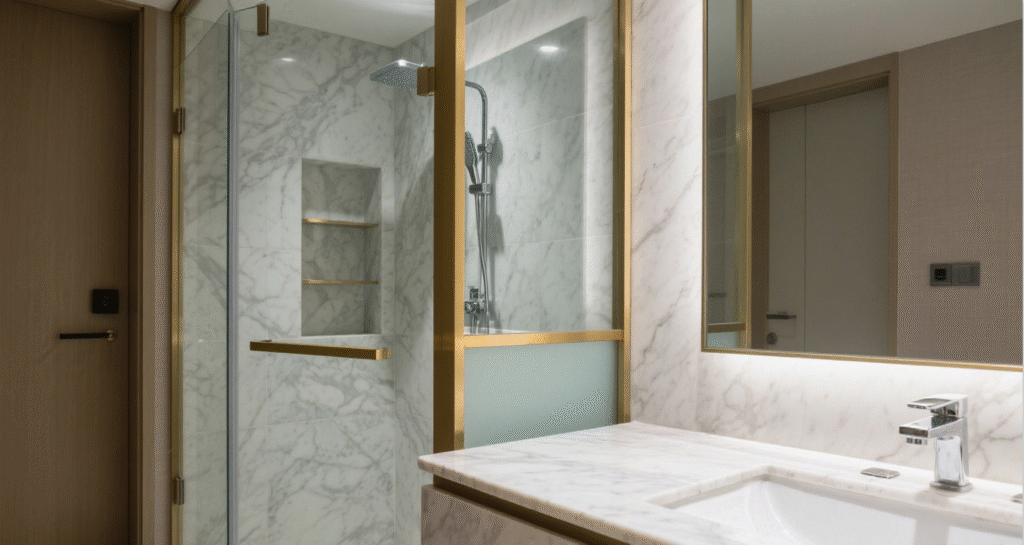
Hi, my name is Leo Liang. I’m a team core member here at Foshan Sinriya and an old enthusiast of the home improvement industry. I’ve observed materials and fashion change through the years. But some pieces possess staying power that goes beyond fashion. They speak a language of quality and durability. Today, I’m going to take you behind the scenes of a project that captures this: the renovation of a five-star hotel lobby, where our Sinriya gold aluminum trim was not a decoration, but part of the architectural narrative. It’s one of the ways in which the best details—the clean lines and inviting warmth of metal—create an unmistakable luxury feel and ambiance.
How Do Details Define Five-Star Luxury?
What turns a good hotel into a great one? It’s a question we find ourselves asking our clients—architects and designers shaping the hospitality future. The answer, I believe, lies in the intentionality of design. It isn’t the massive chandelier or the marble facade of the lobby floor. True luxury is experienced in the details. It’s the touch of a door handle, the elegant transition of floor coverings from one plane to another, and the gentle waltz of light across different surfaces. For one of our most recent five-star hotel projects, the client’s brief was just this: to create an atmosphere of “approachable opulence.” They wanted a room that read grand and sophisticated but warm and welcoming to every single guest who passed through the door. This meant avoiding materials that were gaudy or cold. The design conundrum was how to obtain a material that would provide the golden highlights they were looking for—reminiscent of classic luxury—but with the newer, longer-lasting, and more sophisticated manufacturing. The goal was to balance vintage glamour with current design, so everything was a part of a cohesive and memorable guest experience.
Why Not Brass? The Strategic Choice for Aluminum
The long-standing default choice for a golden metallic accent has long been brass. It has heft, a heavy feeling. But in a public commercial space like a hotel lobby, there are some limitations of traditional brass. It oxidizes, must be polished heavily and continuously to maintain its shine, and is much more costly in materials. That was the point at which our conversation with the design team went to a new, technology-augmented solution: aluminum. Specifically, we selected working with the 6063 T5 aluminum alloy.Known as the “architectural alloy” for very good reason. It’s extremely corrosion resistant, which is vital in a commercial environment where there’s constant cleaning and shifting humidity levels. Its greatest valued asset is its extrudability—its capability to be formed into intricate, precise profiles—clean lines that are hard to mimic with other metals. Further, aluminum is significantly lighter and less costly than brass, which means one can use metallic details more freely in the project budget without losing the high-end look.The decision was simple: aluminum gave us the golden warmth of appearance while presenting us with the exceptional performance and design potential needed for the contemporary luxury space.
How Did Gold Trim Change the Atmosphere of the Hotel?
Having chosen the material, we began working out where Sinriya’s gold trim would go. This was not a question of lining every edge; it was a strategic placement of golden lines to guide the eye, create definition, and provide depth to other materials. In order to frame the grand lobby, we used a 15mm T-profile in brushed gold to create a fluid, but visually distinct, transition between the Italian marble and the deep-blue plush carpeting of the seating areas. One trim line alone accomplished more than closing a gap; it created a deliberate, elegant border. To frame the soaring dark walnut wall panels, we specified a severely restrained 5mm U-channel trim. This trim was recessed between panels, creating narrow, vertical lines of light that caught the ambient glow of the chandeliers, breaking up the monolithic wood surfaces and creating a sense of rhythm and height in the space. The reception desk, a central location in the lobby, was accentuated by an L-shaped corner trim in a 10mm glossy gold, protecting its exposed edges from wear and suitcase damage while delineating it as a key focal point. All profiles were chosen for functional as well as aesthetic purposes.
What Is the Science Behind a Long-Lasting Golden Finish?
A gold finish is nothing short of perfection, yet only durable as it is extravagant. A peel, fade, or scratch finish can instantly downgrade the design. That is why surface treatment process is a process we here at Sinriya take pride in. In this hotel project, we used an anodized finish over a plain powder coat. Although powder coating is great for an extensive variety of colors, anodizing has a definite edge for metallic finishes. It produces a hard, transparent aluminum oxide layer that is part of the metal itself. It’s not a coating that is put on top; it is an integral part of the aluminum. This makes it incredibly abrasion, chipping, and UV-resistant.The gold coloring is embedded in the pores of this anodic coating before it is sealed, so the color is not able to flake or peel off. We offered the designers a variety of options ranging from a reflective shiny polished gold to a less showy brushed gold and a sophisticated matte champagne gold. They ultimately settled on a brushed gold finish for most applications, as its soft texture softened the light, producing a warm glow rather than the harsh glare, and this complemented their task of “approachable opulence” perfectly.
Where Did the Golden Lines Make the Most Impact?
The application of the gold trim also extended to other areas of use to create a cohesive design language in the public spaces of the hotel. In the corridors to the bedrooms, the same 5mm U-channel profile used on the walls of the lobby was integrated into the ceiling, creating long, unbroken lines that gently guided guests on a path of discovery. It created a feeling of journey and anticipation. Inside the hotel’s high-end dining restaurant, a custom-designed 20mm C-channel profile was used to demarcate the massive, velvet-upholstered booths, providing a singular and intimate environment for diners and tying into the design philosophy. Even in the guest bathrooms, a small but significant detail was not forgotten: an L-shaped trim in waterproof anodized gold finish, thin, to edge the shower niche and marble vanity. It’s not a big thing, but something that will be noticed by the guests. It speaks quality and attention to detail and conveys the five-star experience in a very private area. This steady but varied application ensured the gold trim was a recurring theme, and not a repeating device.
How Did This Detail Enhance the Guest Experience and Hotel Brand?
The final result was a stunning makeover. The gold aluminum trim, while a relatively small portion of the overall construction, had a disproportionate impact on the mood. Management explained that the hotel got a lot of compliments from customers regarding the “elegant” and “sophisticated” atmosphere of the interiors. The metallic highlights were successful in giving the expansive space a cozy and inviting atmosphere, as envisioned by the designers.Operationally, the benefits were real. The toughness of the anodized finish delighted the maintenance crew, as it required only regular cleaning, a welcome respite from continual maintenance that was required by traditional brass.The trims protected the edges of expensive materials like marble, wood paneling, and carpet, reducing wear and tear on high-traffic sections and long-term upkeep expense.Ultimately, these well-considered details helped solidify the hotel’s position as the ultimate luxurious getaway, demonstrating that contemporary materials can be harnessed to create an ambiance of timeless sophistication and increased functionality.
What can we learn about the future of luxury materials?
This project is a compelling case study for the future of materials in luxury design. It indicates a clear trend towards solutions with high aesthetics, high performance, and sustainability. The era of picking materials for tradition alone is fading away. Designers and architects today need materials that solve problems. They demand beauty, but also durability, ease of maintenance, and worth. Aluminum, since it can be recycled indefinitely without loss of quality, is an essentially sustainable choice, consistent with the growing role of environmental awareness in architecture.The success of this hotel proves that modern alloys and advanced finishing techniques can not only simulate the look of historic luxury material but often surpass them in all service aspects.Looking forward, I believe the most innovative and successful designs will be those embracing this ethic—hybridizing traditional principles of design with the remarkable potential of modern material science.
References
Formica Corporation. “Metals in Hospitality: Five Design Trends.” It outlines the new trend of using many metals to create more hospitality design, from luxe retreats to rustic sophistication, and how metallics impact lobbies, guestrooms, and bars.
Boca do Lobo. “The Luxurious Allure Of Gold In Interior Design.” This source examines the timeless charm of gold in interior design, its ability to create a warm, refined atmosphere, and the way it can pair with other colours and materials to create an aura of luxury.
Prance Ceiling. “Interior Design Benefits of Aluminum Panels for Walls.” In this piece, the functional benefits of using aluminum for commercial interior application, such as strength for heavy use areas, moisture-resistance, low maintenance requirements, and fire-resistance compliance, are listed together with its modern aesthetic appeal.
Focus Keywords
gold aluminum trim
luxury hotel design
interior metal trim
Sinriya case study
architectural aluminum profiles
